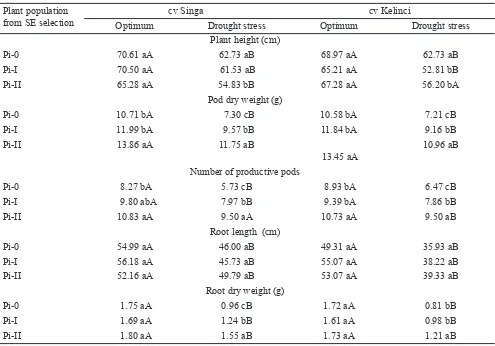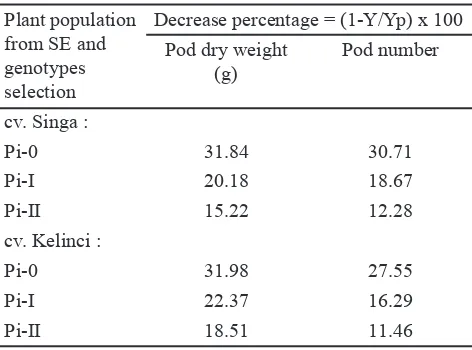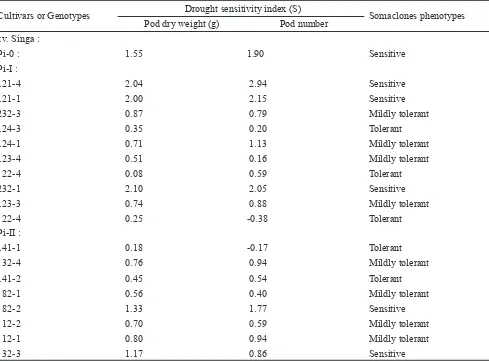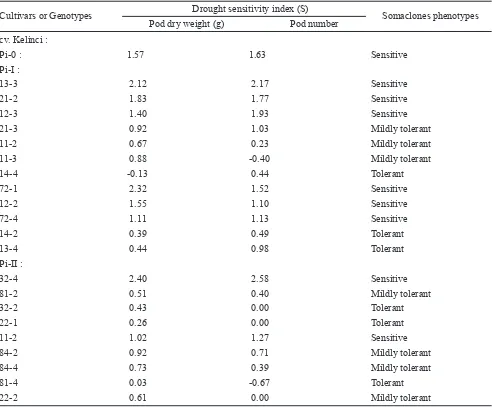INTRODUCTION
Water scarcity represents the most severe constraint to agriculture, account for most of potential yield losses. Drought has been one of the major causes of low yields in peanut production as well as in other crop production in the dry areas in Indonesia. The development of crop cultivars with increased tolerance to drought, both by conventional breeding methods and by in vitro, is an important strategy for agricultural production in the dryland. The use of drought-tolerant cultivars is a more practical and a cost-ef! cient approach in comparison to improving the cultural techniques and facilities for dryland farming.
In vitro selection is one of the methods that may be used to select drought tolerant plants. This method is based on the induction of genetic variation among cells, tissues and or organs in cultured and regenerated plants (Mohamed et al., 2000). Genetic changes occurred during in vitro selection is called somaclonal variation.
Plants regenerated from somaclonal variation were superior than the control plants without in vitro selection, such as in wheat. R3 wheat regenerated from somaclonal variation had height of 60.9 cm, spike length of 10.2 cm and number of pods per spike 54.5, whereas control plants had height of 67.9 cm, spike length of 9.2 cm and number of pods per spike of 43.5 (Ivanov et al., 1998).
Plant tissue culture leading to somaclonal variation has been considered as a rapid and reliable technique for improving crop production characteristics (Maralappanavar et al., 2000). Induction of somaclonal variation followed by in vitro selection can identify plant variance with superior characteristics, such as drought tolerance in soybean (Widoretno and Sudarsono, 2004), and in rice (Adkins et al., 1995).
The indicators of in vitro selection success are the ef! ciency to proliferate the desirable variant cells or tissues as well as to inhibit growth of unwanted cells or tissues using selection agent. PEG or Polyethylene glycol, non penetrating osmotic agent that lowers the water potential of the medium and has been used to simulate drought stress in plants, might be used in an in vitro selection to identify drought-tolerant individuals or mutant cells/tissues. PEG-induced osmotic potential in growth media has a major effect on the formation of embryo somatic in an in vitro culture. The decrease in water potential in the media due to PEG resulted in a decrease in tissue explant proliferation, shoot growth and regeneration (Tewary et al., 2000). This decrease in proliferation was hypothesized to be a result of decreased endogenous polyamines in plant tissues. Polyamine has also been reported to affect morphogenesis, particularly in the formation of somatic embryo in Picea glauca (Kong et al., 1998).
The use of 15% PEG in the media decreased the number of somatic embryo (SE) to 98.5% after only one
Evaluation of Somaclones Peanut Plants Regenerated from Repeat Cycles of In Vitro Selection Against Drought Stress
A Farid Hemon1* and Sudarsono2
1Agroecotechnology Study Program, Agriculture Faculty, Mataram University, NTB, Indonesia 83125 2Agronomy and Horticulture Department, Agriculture Faculty, Bogor Agricultural University (IPB),
Jl. Meranti Kampus IPB Darmaga 16680, Indonesia
Received 22 December 2009/Accepted 22 March 2010
ABSTRACT
The objective of this research was to evaluate the response of somaclonal peanut plants regenerated from repeated cycles of in vitro selection on medium containing 15% polyethylene glycol (PEG; w/v, corresponding to -0.41 Mpa osmotic potential) against drought stress. The R2 generation of peanut plants were used in this experiment with cv “Kelinci” and “Singa” as control cultivars. Drought treatment was the plants irrigated with water to ! eld capacity (optimum condition) while other plants were grown under water de! cit. Drought treatment was given at 16 to 85 days old peanut plants; after 85 days old, the plants were treated under optimum condition until plants were ready to harvest. Drought stress was measured using drought sensitivity index value (S) on scored parameters. Results of the experiment showed that peanut lines produced from repeated cycles of in vitro selection in medium containing 15% PEG were more tolerant to water de! cit, had a better vegetative growth, a higher dry pod yield, and a lower dry pod yield reduction. This research demonstrated that repeated cycles of in vitro selection method was effective to produce drought tolerant peanut genotypes with a higher proline content than genotypes without in vitro selection.
Keywords : somaclonal variation, polyethylene glycol, drought tolerance
selection cycle of three months on SE (Widoretno et al., 2003). Most of selected soybean plants were still drought sensitive. The use of repeated cycles of in vitro selection was expected to increase the number of drought-resistant individual plants and tissues.
Repeated cycles of in vitro selection on PEG containing media have been conducted previously to obtain drought tolerant peanut cultivars (Hemon et al., 2006). The next step of the research is to determine the tolerance level of these cultivars in vivo. Jain (2001) reported that several generations of somaclonal plants have to be assessed for their genetic stability and multiplication rate before they are developed into new cultivars. The objectives of this research was to evaluate the responses of somaclonal plants regenerated from repeated cycles of in vitro selection on PEG containing media towards drought, and to determine their endogenous proline levels.
MATERIALS AND METHODS
Repeated In Vitro Selection, Regeneration and Seed Production of R1 Generation
Embryogenic callus was established from peanut leaf embryo in the MS media (Murashige and Skoog, 1962) containing 2% sucrose, 8 g L-1 agar, 0.1 mg L-1 vitamins and
amino acids (glycine, thiamin, pyridoxin and niacin), and 16 mM picloram (MS-P16 medium) in 25 mL medium for each culture.
Callus were then subcultured on the same medium with an addition of 15% PEG. All cultures were grown on a ! lter paper support in a liquid medium. PEG at 15% concentration was a sub-lethal concentration (Rahayu et al., 2005). PEG at this level inhibited SE proliferation up to " 95% compared to proliferation in the media without PEG.
Five hundred embryogenic callus (4000 SE) were evaluated during the ! rst selection cycle. Each culture consists of ! ve embryogenic callus (8-10 SE). Cultures were incubated at 26 oC in the dark and sub-cultured twice
into fresh media during three months period. Embryogenic callus and SE developing from the PEG media were hence called Pi-I, i.e. the results of the ! rst selection cycle, were multiplied in MS-P-16 media without PEG.
Half of Pi-I somatic embryo were subcultured to regenerate Pi-I plantlets, and another half were used as explants for the second selection. SE Pi-I were then reselected in media with 15% PEG before subcultured to a fresh media without PEG for three months. Surviving SE
and embryogenic callus from the second cycle were then proliferated in MS-P16 media without PEG. The surviving SE from the second cycle are called Pi-II. SE Pi-II were then regenerated to produce Pi-II plantlets.
Pi-I and Pi-II plantlets were then grown into R0 plants and were planted in plastic pots with mix of (pasteurised) soil and sand and maintained in the green house until plants were ready to harvest. Seeds from these plants were then replanted to produce R1 plants, which were then grown under the green house condition (as above).
Drought Tolerance Evaluation of Somaclonal Plants
R2 plants were used in this evaluation (Table 1). Pi-0 population from cv “Kelinci” and “Singa” without in vitro selection were used as control plants. Seeds from R2 generation were planted and thinned to one plant per polybag.
Before applying the drought treatment, plants were watered daily to ± 90% ! eld capacity until they were 15 days old. Field capacity was estimated by watering to media saturation. When plants were 16 days old the other half were exposed to drought treatment where as the other half were maintained under optimal condition (watering daily to ! eld capacity). Drought treatment was applied for 69 days (i.e. terminated when plants were 85 days old) before transferred to optimal condition until the plants were ready to harvest. Watering of the drought-treated plants was conducted when leaves started wilting in 70% of plants.
Drought tolerance was measured using Drought Sensitivity Index (S) as described by Fischer and Maurer (1978). In summary, S = (1-Y/Yp) / (1-X/Xp), where (Y) = average of pod number, pod dry weight, root length, root dry weight of a drought-treated genotype; (Yp) = average of variables of optimally grown genotype; (X) = variable value of all drought-treated genotypes; and (Xp) = variable values of all optimally grown genotype. Plants were classi! ed as tolerant if having sensitivity Index of < 0.5, mildly tolerant if 0.5 # S # 1, and sensitive if S > 1.
Proline Content
Proline content was measured on the second leaf from the tip when plants were 60 days after planting and had experienced six times of drought treatment. Proline content was analysed using methods developed by Bates et al. (1973).
Table 1. R2 generation of peanut genotypes following in vitro selection. Cultivar Plant population
from SE selection
Number of genotypes
Genotype number
Singa Pi-I 10 121-4, 121-1, 232-3, 124-3, 124-1, 123-4, 22-4, 232-1, 123-3, 22-2 Pi-II 8 141-1, 32-4, 141-2, 82-1, 82-2, 12-2, 12-1, 32-3
RESULTS AND DISCUSSION
The Effect of Drought Stress on Plant Growth
Drought tolerance was evaluated by comparing yields and yield components in optimal and drought stress conditions. Drought stress signi! cantly reduced plant vegetative growth and pod yield (Table 2). Drought stress was reported to reduce number and dry weight of peanut
pods, and this reduction was, at least partly, caused by a delay in gynophore initiation and elongation (Chapman et al., 1993).
Plants under drought stress were signi! cantly shorter than plants grown under optimal condition. Similarly, plants regenerated from SE selection under drought stress were shorter than control cultivars of “Singa” and “Kelinci”. The second cycle of SE selection, cv “Singa” had the shortest plants (Table 2).
Plant population from SE selection
cv Singa cv Kelinci
Optimum Drought stress Optimum Drought stress
Plant height (cm)
Pi-0 70.61 aA 62.73 aB 68.97 aA 62.73 aB
Pi-I 70.50 aA 61.53 aB 65.21 aA 52.81 bB
Pi-II 65.28 aA 54.83 bB 67.28 aA 56.20 bA
Pod dry weight (g)
Pi-0 10.71 bA 7.30 cB 10.58 bA 7.21 cB
Pi-I 11.99 bA 9.57 bB 11.84 bA 9.16 bB
Pi-II 13.86 aA 11.75 aB
13.45 aA
10.96 aB
Number of productive pods
Pi-0 8.27 bA 5.73 cB 8.93 bA 6.47 cB
Pi-I 9.80 abA 7.97 bB 9.39 bA 7.86 bB
Pi-II 10.83 aA 9.50 aA 10.73 aA 9.50 aB
Root length (cm)
Pi-0 54.99 aA 46.00 aB 49.31 aA 35.93 aB
Pi-I 56.18 aA 45.73 aB 55.07 aA 38.22 aB
Pi-II 52.16 aA 49.79 aB 53.07 aA 39.33 aB
Root dry weight (g)
Pi-0 1.75 aA 0.96 cB 1.72 aA 0.81 bB
Pi-I 1.69 aA 1.24 bB 1.61 aA 0.98 bB
Pi-II 1.80 aA 1.55 aB 1.73 aA 1.21 aB
Table 2. The effect of drought stress on plant growth Pi-0 (without in vitro selection) of R2 somaclone population generated from SE of cv “Singa” and “Kelinci” following the ! rst selection cycle (Pi-I), or repeated selection cycles (Pi-II) of drought condition in vitro in PEG media
Notes: Values followed by same letters within a row are not signi! cantly different by Duncan Multiple Range Test (P < 0.05)
Plants of “Singa” and “Kelinci” regenerated from the second cycle of SE selection had longer roots and a greater root dry weight compared to those from other selection methods (Figure 1). Pod weight and number of dry pods in control plants were less than those in plants regenerated from in vitro selection for drought tolerance. Pod weight and number of dry pods obtained from the second cycle was greater than those from the ! rst cycle. However, there was no signi! cant difference between optimum and drought condition in term of number of pods in cv “Singa” (Table 2).
Plant growth was affected by the interaction between cultivars and selection cycles (data not shown). “Singa” and “Kelinci” plants from the second cycle had a greater pod dry weight, number of pods and root dry weight compared to the plants from the ! rst cycle and from the control plants.
The greatest decrease in pod dry weight and number of empty pods following drough treatment were experienced by control plants of “Singa” and “Kelinci”. The percentage of decrease were 31.84% and 31.98% for pod dry weight, 30.71% and 27.55% for dry seed pods of “Singa” and “Kelinci” respectively. The plants from the second cycle had less signi! cant decrease, i.e. 15.22% and 12.28% for pod dry weight, and 18.51% and 11.46% for dry seed pods, of “Singa” and “Kelinci” respectively (Table 3).
In general, plants from the second cycle had better vegetative growth, greater yield, and less decrease in dry pod weight and pod number following drought treatment compared to plants from the ! rst cycle and control plants. The effects of drought treatment on plant’s physical condition, pod yields and root growth were presented in Figure 1.
Sensitive plants wilted earlier than tolerant plants following drought treatment. Tolerant plants regenerated
from SE selection might have a certain mechanism to withstand the drought condition, probably due to genetic changes occurred during in vitro selection. These changes resulted in an accumulation of mutant cells or tissues rendering them more tolerant to drought and had a better adaptation to media with 15% PEG. Previous studies demonstrated that plants from the second cycle had 15% more survived embryogenic callus than the plants from the ! rst selection cycle (Hemon et al., 2006).
Plant Tolerance to Drought Stress
Plant tolerance to drought was measured using Sensitivity Index (S) and the results are presented in Table 4 and 5. Based on calculation on S value on pod dry weight, number of pods, root length and root dry weight, S value for “Singa” ranged between 0.71–1.90, “Kelinci” 1.17–1.63. The plants regenerated from the ! rst cycle had S value of between 0.72–1.05 for “Singa” and 1.00–1.33 for “Kelinci”. The plants regenerated from the second cycle had S value of between 0.20–0.74 for “Singa” and 0.75–1.12 for “Kelinci”.
Based on the S value on pod dry weight, “Singa” and “Kelinci” plants from the second selection cycle were classi! ed as mildly tolerant with S value of 0.74 and 0.90, respectively, “Singa” plants from the ! rst selection cycle were mildly tolerant ( S value of 0.97) and “Kelinci” were sensitive with S value of 1.10. These results indicated that it is possible to avoid yield loss and to maintain root growth under drought stress.
Not all lines showed increased tolerance to drought following repeated cycles of in vitro selection. Some lines even had S value of greater than the control. Out of 10 lines of “Singa” tested using repeated cycles of in vitro selection, three lines were classi! ed as sensitive (30%), four lines as mildly tolerant, and three lines as tolerant, whereas out of 12 lines of “Kelinci” tested, six lines were classi! ed as sensitive (50%), three lines (25%) as mildly tolerant, and three lines (25%) as tolerant. These results might have been caused by the random and spontaneous characteristics of somaclonal variation (Karp, 1995). Results from the second cycle of selection is presented in Table 5.
In addition, this selection method has reduced the number of sensitive lines with S value of > 1 after the second selection (Table 5). These results demonstrated that tolerance level to drought can be improved using this technique. Similar results were reported by Adkins et al. (1995) in rice and by Widoretono and Sudarsono (2004) in soybean. The use of PEG media was effective to select drought tolerant callus cells, which subsequently regenerated to develop lines with a higher tolerance to drought stress compared to the parental lines (Adkin et al., 1995). Widoretono and Sudarsono (2004) reported that repeated selection in 15% PEG media was effective to produce mutant cells or mutant tissues of soybeans. These cells and tissues can then regenerated to develop drought tolerant mutant somaclones.
Qualitative variability of the R0 and R1 plants were found more on plants regenerated from the second cycle, i.e. Plant population
from SE and genotypes selection
Decrease percentage = (1-Y/Yp) x 100 Pod dry weight
Table 3. Decrease percentage of weight and pod numbers of Pi-0 population (without in vitro selection) and of R2 somaclone population generated from SE of cv “Singa” and “Kelinci” following selection of drought condition in vitro
Plant population from SE and
genotypes selection
Drought sensitivity index (S) Somaclones
phenotypes Pod dry weight
(g)
Pod number Root length (cm)
Root dry weight (g) cv. Singa :
Pi-0 1.55 1.90 0.71 1.22 Sensitive
Mildly Tolerant Mildly tolerant
Pi-I 0.97 1.05 0.81 0.72
Pi-II 0.74 0.73 0.20 0.38
cv. Kelinci :
Pi-0 1.57 1.63 1.17 1.42 Sensitive
Sensitive Mildly tolerant
Pi-I 1.10 1.00 1.33 1.05
Pi-II 0.90 0.75 1.12 0.81
Table 4. Drought Sensitivity Index of various agronomical characters of Pi-0 population (without in vitro selection) and of R2 somaclone population generated from SE of cv “Singa” and “Kelinci” following selection of drought condition in vitro
Notes : Drought sensitivity index (S) and somaclones phenotypes based on pod dry weight
Cultivars or Genotypes Drought sensitivity index (S) Somaclones phenotypes
Pod dry weight (g) Pod number
cv. Singa :
Pi-0 : 1.55 1.90 Sensitive
Pi-I :
121-4 2.04 2.94 Sensitive
121-1 2.00 2.15 Sensitive
232-3 0.87 0.79 Mildly tolerant
124-3 0.35 0.20 Tolerant
124-1 0.71 1.13 Mildly tolerant
123-4 0.51 0.16 Mildly tolerant
22-4 0.08 0.59 Tolerant
232-1 2.10 2.05 Sensitive
123-3 0.74 0.88 Mildly tolerant
22-4 0.25 -0.38 Tolerant
Pi-II :
141-1 0.18 -0.17 Tolerant
32-4 0.76 0.94 Mildly tolerant
141-2 0.45 0.54 Tolerant
82-1 0.56 0.40 Mildly tolerant
82-2 1.33 1.77 Sensitive
12-2 0.70 0.59 Mildly tolerant
12-1 0.80 0.94 Mildly tolerant
32-3 1.17 0.86 Sensitive
nine qualitative characters with frequency of 5–55%. These results provided a further proof that the chance of obtaining tolerant lines were greater in plants regenerated from the repeated selection (the second cycle) rather than the single selection only (Hemon et al., 2006).
Proline Content of Drought-treated Somaclonal Plants
Proline has an important role in plant tolerance to drought (Watanabe et al., 2000). Increased tolerance to drought resulted in accumulation of compounds protecting Tabel 5. Lanjutan
Table 6. Proline and sugar content of Pi-0 population (without in vitro selection) and of R2 somaclone population generated from SE of cv “Singa” and “Kelinci” following selection of drought condition in vitro
Population of SE selection
cv. Singa cv. Kelinci
Optimum Drought Increase (%) Optimum Drought Increase (%)
Proline [µg (g dry weight)-1]
Pi-0 3010.5 cA 4119.3 bA 36.8 2709.5 cA 3380.7 cA 24.8
Pi-I 4766.7 bB 7181.1 aA 50.7 4447.5 bA 5653.0 bA 27.1
Pi-II 7217.0 aA 8608.0 aA 19.3 6996.4 aA 7941.0 aA 13.5
Notes: Values followed by same letters within a row are not signi! cantly different by Duncan Multiple Range Test ( P < 0.05) cv. Kelinci :
Pi-0 : 1.57 1.63 Sensitive
Pi-I :
13-3 2.12 2.17 Sensitive
21-2 1.83 1.77 Sensitive
12-3 1.40 1.93 Sensitive
21-3 0.92 1.03 Mildly tolerant
11-2 0.67 0.23 Mildly tolerant
11-3 0.88 -0.40 Mildly tolerant
14-4 -0.13 0.44 Tolerant
72-1 2.32 1.52 Sensitive
12-2 1.55 1.10 Sensitive
72-4 1.11 1.13 Sensitive
14-2 0.39 0.49 Tolerant
13-4 0.44 0.98 Tolerant
Pi-II :
32-4 2.40 2.58 Sensitive
81-2 0.51 0.40 Mildly tolerant
32-2 0.43 0.00 Tolerant
22-1 0.26 0.00 Tolerant
11-2 1.02 1.27 Sensitive
84-2 0.92 0.71 Mildly tolerant
84-4 0.73 0.39 Mildly tolerant
81-4 0.03 -0.67 Tolerant
22-2 0.61 0.00 Mildly tolerant
Notes: Drought sensitivity index (S) and somaclones phenotypes based on pod dry weight
Cultivars or Genotypes Drought sensitivity index (S) Somaclones phenotypes
cells from damages caused by low water potential (Jensen et al., 1996). Increase in drought-tolerance also increased endogenous proline content (Table 6). SE selection using 15% PEG signi! cantly increased proline content at both optimal and non-optimal/drought condition. Plants regenerated from the second cycle of cv “Singa” and “Kelinci” had a higher endogenous proline content than those from the ! rst cycle. In addition, the increase in proline content of plants regenerated from the second cycle was lower than control plants.
CONCLUSION
Somaclones (R2) regenerated from repeated cycles of in vitro culture on media supplemented with 15% PEG had a better vegetative growth with a higher pod yield and a less decrease of pod yield compared to R1 plants, or to control plants (without in vitro selection).
Somaclones (R2) regenerated from SE cv “Singa” and cv “Kelinci” had a better drought tolerance index with pod dry weight of 11.75 and 10.96 g plant-1, respectively. The
second cycle of SE selection in cv “Kelinci” produced a greater number of drought-tolerant individuals than those produced in the ! rst cycle. In addition, repeated cycles of in vitro selection resulted in plants with a higher proline content.
REFERENCES
Adkins, S.W., R. Kunanuvatshidah, I.D. Godwin. 1995. Somaclonal variation in rice drought tolerance and other agronomic characters. Aust. J. Bot. 43:201-209.
Bates, L.S., R.P. Waldren, I.D. Teare. 1973. Rapid determination of free proline for water stress studies. Plant and Soil 39:205-207.
Chapman, S.C., M.M. Ludlow, F.P.C. Blamey, K.S. Fisher. 1993. Effect of drought at pod ! lling on utilization of water and growth of cultivars of groundnut. Field Crop Res. 32:243-255.
Fischer, R.A., R. Maurer. 1978. Drought stress in spring wheat cultivars : I. Grain yield responses. Aust. J. Agric. Res. 29:897-912.
Hemon, A.F., L. Ujianto, Sudarsono. 2006. Seleksi berulang dan identi! kasi embrio somatik kacang tanah yang insensitif polietilena glikol (PEG) dan ! ltrat kultur Sclerotium rolfsii. Agroteksos 16:21-32.
Ivanov, P., Z. Atanassov, V. Milkoca, L. Nikolova. 1998. Culture selected somaclonal in ! ve Triticum aestivum L., genotypes. Euphytica 104:167-172.
Jain, S.M. 2001. Tissue culture-derived variation in crop improvement. Euphytica 118 :153-156.
Jensen, A.B., P.K. Busk, M. Figueras, M.M. Alba, G. Peraccia, R. Messeguer, A. Goday, A.M. Pages. 1996. Drought signal tranduction in plant. Plant Growth Reg. 20:105–110.
Karp, A. 1995. Somaclonal variation as a tool for crop improvement. Kluwer Acad. Publ. The Netherlands. Kong, L., S.M. Attree, L.C. Fowke. 1998. Effect of poly-ethylene glycol and methylglyoxal (guanylhydra-zone) on endogenous polyamine levels and somatic embryo maturation in white spruce (Picea glauca). Plant Sci. 133:211-220.
Maralappanavar, M.S., M.S. Kuruvinashetti, C.C. Harti. 2000. Regeneration, establishment and evaluation of somaclones in Sorghum bicolor (L.) Moench. Euphytica 115:173-180.
Mohamed, M.A.H., P.J.C. Harris, J. Henderson. 2000. In-vitro selection and characterisation of a drought tolerant clone of Tagetes minuta. Plant Sci. 159:213-222.
Murashige, T., F. Skoog. 1962. A revised media for rapid growth and bioassay with tobacco tissue cultures. Physiol. Plant 15:473-493.
Rahayu, E.S., E. Guhardja, S. Ilyas, Sudarsono. 2005. Seleksi in-vitro embrio somatik kacang tanah pada media dengan polietilena glikol untuk mensimulasikan cekaman kekeringan. Majalah Ilmiah Biologi BIOSFERA.
Tewary, P.K., A. Sharma, M.K. Raghunath, A. Sarkar. 2000. In-vitro response of promising mulberry (Morus sp.) genotypes for tolerance to salt and osmotic stresses. Plant Growth Reg. 30:17–21.
Watanabe, S., K. Kojima, Y. Ide, S. Sasaki. 2000. Effect of saline and osmotic stress on proline and sugar accumulation in Populus euphratica in-vitro. Plant Cell Tissue Organ Cult. 63:199-206.
Widoretno, W., E. Guhardja, S. Ilyas, Sudarsono. 2003. Reaksi embrio somatik kedelai terhadap polietilena glikol dan penggunaannya untuk seleksi in-vitro terhadap cekaman kekeringan. Hayati 10:134-139.




